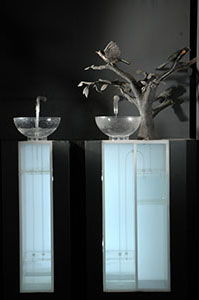 |
||
| [close] | ||
 |
© Institute and Museum of the History of Science |
Heron's Fountain and Branch with singing birdsWorking model Opera Laboratori Fiorentini Ancient treatises on pneumatics contain numerous references to remarkable devices, such as fountains that suddenly begin to spurt water, and altars bearing branches with singing birds perched on them. In antiquity the term "pneumatics" was used to indicate all of the phenomena and devices driven by the pressure of air, water or steam. One of the most famous devices of this type is the so-called "Heron's fountain", described by the Alexandrine scholar in his Treatise on Pneumatics (mid-1st century A.D.). For the fountain to operate, the middle globe is to be partially filled with water. The device is primed by pouring water into the cup near the top. Through pipe A, the water flows into the tank below, expels the air in it, and then rises to the middle tank through pipe B. At this point, the water, thrust by the pressure of the air, is channeled into the smallest pipe C, and begins to spurt out. The device remains in operation until the lower tank is full and the upper one empty. In the ancient world, these machines served a dual purpose. They aroused wonder in the eyes of the spectators, thus glorifying the sovereign who had commissioned the device; and they illustrated, for those engaged in studying mechanics, the marvelous effects deriving from the contiguity of elements. Among the devices described in the ancient treatises on pneumatics, the "branch with singing birds" was one of the most renowned. Water poured into the cup at the top is channeled, through a narrow duct, toward a tank placed at the base from which it flows out, forcing air to rise through a pipe leading to a second recipient. At this point, the water pressure forces the air into a pipe running through the bird's body, in which a tiny whistle is inserted in a bottleneck where the air pressure produces a chirping sound. |